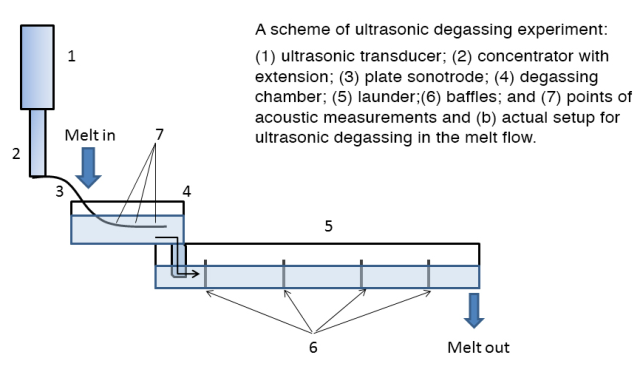Researchers from Brunel University, London have developed a continuous process to apply ultrasound degassing upstream from the casting mold and to larger melt volumes. The team had already proved that ultrasound degassing of aluminium alloys is greener, cleaner, and more cost-effective than existing techniques.
 Schematic of the plate sonotrode process
Schematic of the plate sonotrode process
De-gassing of molten aluminium alloys is an important process, and if not done would result in highly porous solid metals, making them unfit for further applications.
Project lead Prof Dmitry Eskin of the Brunel Centre for Advanced Solidification Technology explains: “The most common current method, argon rotary degassing, is energy intensive, involves rotating brittle parts and expensive argon gas.
“Having proved that ultrasound is cheaper, greener and just as efficient we wanted to look at achieving a continuous process that would allow us to apply degassing to much larger melt volumes and upstream from the casting mould.
“Our experiments showed that a plate sonotrode gave a continuous degassing efficiency of at least 50 per cent in the melt flow rising to 75 per cent in batch operation. This is even more impressive than a standard cylindrical sonotrode.”
Prof Eskin is looking for an industrial partner to address certain engineering complexities. According to him, there are much more efficiencies that need to be explored.
Our initial experiments were with a flat S-shaped sonotrode positioned at the bottom of the through-flow degassing chamber.
Although the efficiency of degassing was very good, we met some engineering challenges that need to be addressed.
For example we found that the connecting the flat sonotrode to the ultrasonic transducer and the shape and dimensions of the plate sonotrode should be optimised through engineering solutions to assure industrial-scale operation.
In summary, to scale up from the lab to pilot studies we need an industrial engineering partner now that we know the science is sound.
Prof Eskin
References